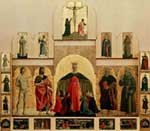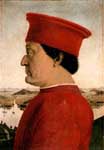Piero della Francesca was born in Borgo Sansepolcro between 1415 and 1420. He trained in Florence with Domenico Veneziano and worked with him on the frescos in the chorus of S. Egidio in Florence (nothing survived to the present day). His early works, executed before 1450, reveal the artist’s style: rigorous perspective, perfect  geometry of volumes, grandiose human figures are in an atmosphere with diffuse light, so that the figures themselves appear suspended in time.
geometry of volumes, grandiose human figures are in an atmosphere with diffuse light, so that the figures themselves appear suspended in time.
In 1442 Piero returned to Borgo Sansepolcro where he presented himself as a candidate for the position of councillor. The Confraternita della Misericordia (a brotherhood) commissioned a polyptich which should have been finished in three years (it took the painter fifteen years to finish it). The polyptich is made up of twenty three parts and some of them, like the predellas, were painted by the artist’s helpers and followers. The impression of volume and the stauesque quality of bodies reveal the influence of Donatello on this painter, whereas the influence of Masaccio can be seen in the altar piece above the polyptich. In the same period he was painting the first panels of the polyptich, Piero also painted the Baptism of Christ, currently in the London National Gallery. In this painting the transparency of the atmosphere and the clear radiance of the landscape are reminiscent of the works of Domenico Veneziano and Beato Angelico. The rigorous perspective in which Christ is the central element give this painting the balance and harmony which are typical of works by this artist.
In about 1451 the painter went to Rimini where, in the Temple of the Malatesta family, he worked on the votive fresco with the portrait of Sigismondo Pandolfo Malatesta.
In 1452, when Bicci di Lorenzo died, the Bacci family invited Piero to continue the fresco in the chorus of the church of St Francis in Arezzo. The fresco was to show the History of the True Cross. The scenes are depicted on three levels; the monumental figures are like statues made of pure geometric shapes on which fabrics are elegantly draped. No special feelings can be read on the people’s faces. This is particularly obvious in the paintings depicting the Adoration of the holy wood and meeting of Solomon with the Queen of Sheba. In the picture depicting the Battle of Heraclius against Chosroes the painter was helped by his pupils; the composition is simpler. In Dream of Constantine the glow illuminating the scenes reveals how incredibly sensitive to the effects of light the artist was.
 Among the painter’s most important works is a small painting, Flagellation of Christ, painted between 1455 and 1460 in Urbino. The composition is divided into two scenes by a column and in the middle of the peopleon the right side of the painting is Oddantonio da Montefeltro, Federico’s half-brother, who was murdered in a conspiracy. The scenes on the left side, depicting the Flagellation, could hint at the Martyrdom of the young prince.
Among the painter’s most important works is a small painting, Flagellation of Christ, painted between 1455 and 1460 in Urbino. The composition is divided into two scenes by a column and in the middle of the peopleon the right side of the painting is Oddantonio da Montefeltro, Federico’s half-brother, who was murdered in a conspiracy. The scenes on the left side, depicting the Flagellation, could hint at the Martyrdom of the young prince.
In those same years he painted the cuspid table of the polyptich in Sant'Antonio delle Monache in Perugia, depicting the Annunciation. He was often at the court of the Montefeltro family and painted the Portrait of Battista Sforza and Federico da Montefeltro. Among his last works are Madonna of Senigallia (1470) and the Holy conversation of Brera (1472-74).
An eye disease forced him to stop painting and he concentrated on studying perspective; he wrote the treatise De prospectiva pingendi which aims at teaching painters the secrets the perspective, and the booklet De quinque corporibus regularibus.
He died on 12th October 1492.